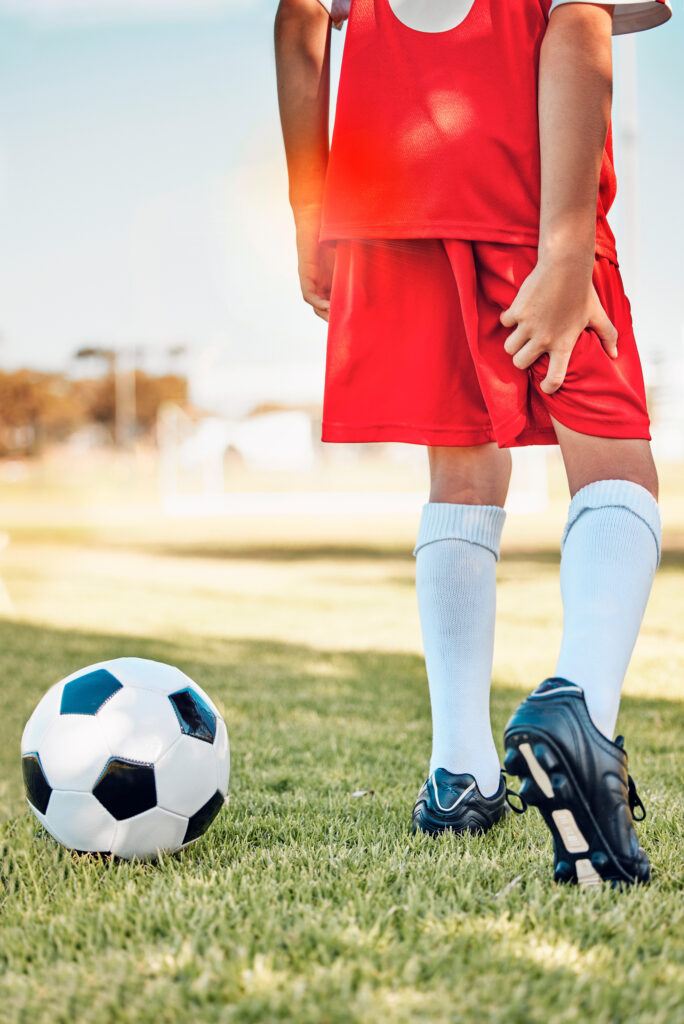What is a Hamstring Strain?
The hamstrings are the group of three muscles — the biceps femoris, semitendinosus, and semimembranosus — that run down the back of the leg from the thigh to the knee and help bend/flex the knee and extend/ straighten the hip. A hamstring strain, sometimes called a pulled hamstring, involves straining or pulling one of the hamstring muscles.
Hamstring injuries are typically less common in young children, but as children reach their teen years and experience growth spurts, they are more likely to suffer from a muscle strain injury; this is because the leg bones may grow faster than the muscles, pulling them tight and making them more susceptible to getting stretched too far.
How Do Hamstring Strains Occur?
Muscle overload is the main cause of hamstring muscle strain. This can happen when the muscle is stretched beyond its limit or challenged with a sudden load. Teens who play sports that involve sprinting or jumping with sudden stops and starts like track, soccer, football, lacrosse, basketball, football, tennis, and dance are more at risk of hamstring strains.
Some of the more common things that can contribute to a hamstring strain include:
- Poor conditioning – tight or weak muscles that don’t stretch well lose some of their ability to absorb energy and are more likely to strain than muscles that are kept strong and flexible. Be in shape to play your sport. Don’t play your sport to get in shape.
- Poor technique – an improper running technique, for example, can increase the stress on your hamstring muscles.
- Returning to activities too quickly after an injury – hamstring strains need plenty of time and rest to heal completely. Coming back from a strain too soon will leave your teen athlete more likely to reinjure their hamstring.
- Previous hamstring injury – young adults who have had one hamstring injury are more likely to have another one.
- Muscle imbalance – if the quadricep muscles along the front of the thigh are more developed than the hamstring muscles, injury to the hamstring muscles might be more likely.
What are the Symptoms of a Hamstring Strain?
A hamstring injury typically causes a sudden, sharp pain in the back of the thigh. When a muscle is strained there might also be a popping or tearing sensation causing sudden and severe pain. Swelling and tenderness in the back of the thigh usually develops within a few hours with bruising or a change in skin color along the back of the leg. Some teens experience muscle weakness or are not able to put weight on their injured leg.
Treatment for Hamstring Strains
The good news is that only the most severe muscle tears require surgery. Most hamstring strains will heal on their own or with some physical therapy to improve the range of motion and strength of the injured leg. To treat a hamstring strain, follow these tips:
- Rest – stop any physical activity
- Ice – ice the hamstring for about 20 minutes, 2 to 3 times a day to relieve pain and reduce swelling
- Compression – a bandage or wrap can reduce swelling and ease pain
- Elevation –keep your leg raised above the level of the heart
- Over-the-counter non-steroidal anti-inflammatory medications
Keeping your muscles in good shape is the best way to prevent hamstring injuries:
- Warm up properly to keep your muscles strong and flexible. Your child should adopt a good stretching program so that their muscles don’t get a shock when they do an intense workout.
- Increase the duration and intensity of your exercise slowly. A good rule of thumb is to add no more than 10% each week to the miles they run or the time they spend playing a sport.
If you feel pain in your thigh, stop activity immediately. If there’s a chance that your teen might have strained your hamstring, they should rest until their leg feels strong with no pain.
Recovery Time for a Hamstring Strain
Hamstring strains can be mild, with little pain and a short recovery time. Or, they can be severe and require surgery and crutches.
There are three grades of a hamstring injury:
- Grade 1: Strain. Sudden, radiating pain in the back of your thigh. Your teen’s strength won’t be affected, but it’ll be hard for them to move their leg
- Grade 2: Partial Tear. More painful than grade 1
- Grade 3: Severe tear. Worse pain, tenderness, swelling and bruising
We Can Help Your Child with a Hamstring Strain
Getting the right diagnosis for your child’s injury is the first step in a speedy recovery. At The Pediatric Orthopedic Center, our award-winning pediatric specialists will examine their leg and ask questions to learn how the injury happened and ascertain the degree of pain. This will help us to figure out the grade of the strain and the best and fastest treatment.
Most hamstring injuries in teens that involve partial tearing of the muscles heal over time and with physical therapy. If your teen has a complete tear of one of his/her hamstring muscles or tendons, the doctor might recommend surgery to reattach the tendon to the bone or fix the tendon. It’s important for your child to follow the doctor’s recommendations when it comes to hamstring injuries. Wait until they are cleared by our team to return to athletics. The amount of required time off depends on the severity of the injury, but may range from two weeks to six months. If your adolescent/teen has pain in the hamstring, please contact us at (973) 538-7700 or visit our website at pediatricorthopedics.com.



